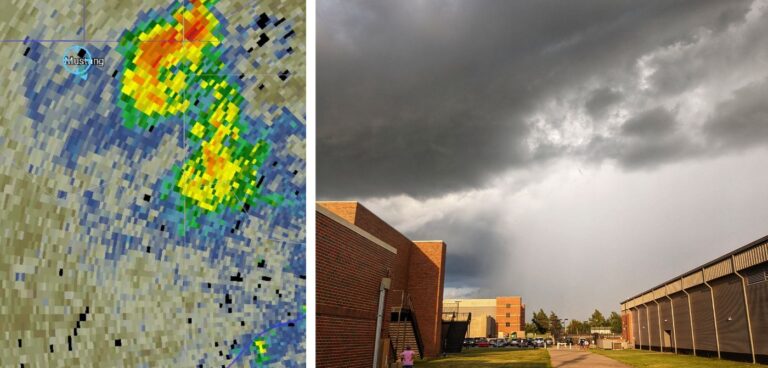The Cooperative Institute for Severe and High-Impact Weather Research and Operations (CIWRO) at the University of Oklahoma has been creating radar simulations of winter storms to help forecasters make short-term predictions about what can’t be seen inside a storm.
Research scientists at CIWRO analyze dual-polarization radar data and by studying how precipitation forms and the various environmental factors that lead to severe weather, they create radar-based algorithms to help increase forecasters’ lead time to predict imminent winter weather hazards that can disrupt transportation on the ground and in the air.
Jacob Carlin, a research scientist at CIWRO, said, “We use models to simulate what a hypothetical radar would sense inside of a storm, and we compare that to what we see in real life. Equations model how snowflakes and raindrops scatter energy back to the radar, and we have to make informed assumptions about the density of the snowflake, the shape of raindrops and how they’re oriented.”
The team has developed microphysical retrieval equations, which indicate the size, quantity and rate of snowfall. The equations, written by Alexander Ryzhkov, senior research scientist at CIWRO, and Petar Bukovcic, CIWRO researcher, have been proven particularly accurate when compared to data that researchers have collected from flying airplanes through snowstorms.
“So far, we’re finding good agreement between what these equations tell us from the radar and what is happening in reality,” Carlin said. “That’s really useful because we typically don’t have observations from inside snowstorms outside of specialized field campaigns. In general, radar is our primary tool for looking aloft inside of a snowstorm, so if we’re able to use that radar data to get information about the snowfall, that’s useful not only to forecasters in real time, but also for comparing to our weather forecast models.
“Sometimes in autumn the leaves on the ground will get caught up in swirls of wind. They’re like tracers in the air. They’re making visible the wind patterns that are always there. Most of the time we can’t see it, but when we have leaves on the ground, we get to visualize what the atmosphere is actually doing. To me, that’s analogous to what radar can do. We have these processes, but radar allows us to fully visualize what the atmosphere is doing.”
Carlin is currently focusing on data that can predict downbursts, sudden bursts of strong wind from the base of a thunderstorm that are directed at the Earth’s surface. Downbursts evolve quickly when falling hail, graupel or rain melt and evaporate, cooling the air. The researcher hopes to give forecasters five- to 10-minute head starts to predict downbursts.
“Downbursts are a real forecasting challenge because they evolve quickly. We don’t have a lot of lead time or reliable detection until it’s already occurring. The surge toward the ground spreads out and causes a hazard to aviation. The wind itself is the main damage-causing factor; however, they are often accompanied by additional hail and graupel, which also causes damage.”
The team’s next challenge is tapping into dual-polarization radar data for nowcasting, or detailed forecasting up to six hours prior to the weather event. Carlin said, “We have a lot of radar-based algorithms that try to detect severe weather phenomena, but our goal is to develop tools to predict severe weather in advance using dual-polarization data. We’re trying to develop a tool that looks aloft, sees that snowfall developing, then projects down to the surface when and where it might reach. Because snow falls slowly compared to rain, we can make predictions maybe 30 to 60 minutes in advance regarding where a heavy snowband might develop.
“Another example is using dual-polarization data combined with models to try to predict when the precipitation type in a winter snowstorm might change in a given location. At some point, snow may change to freezing rain. That has a big impact on ice accumulation, which impacts power. We’re trying to use the radar data as best we can to be able to make predictions about when that changeover might occur.”



